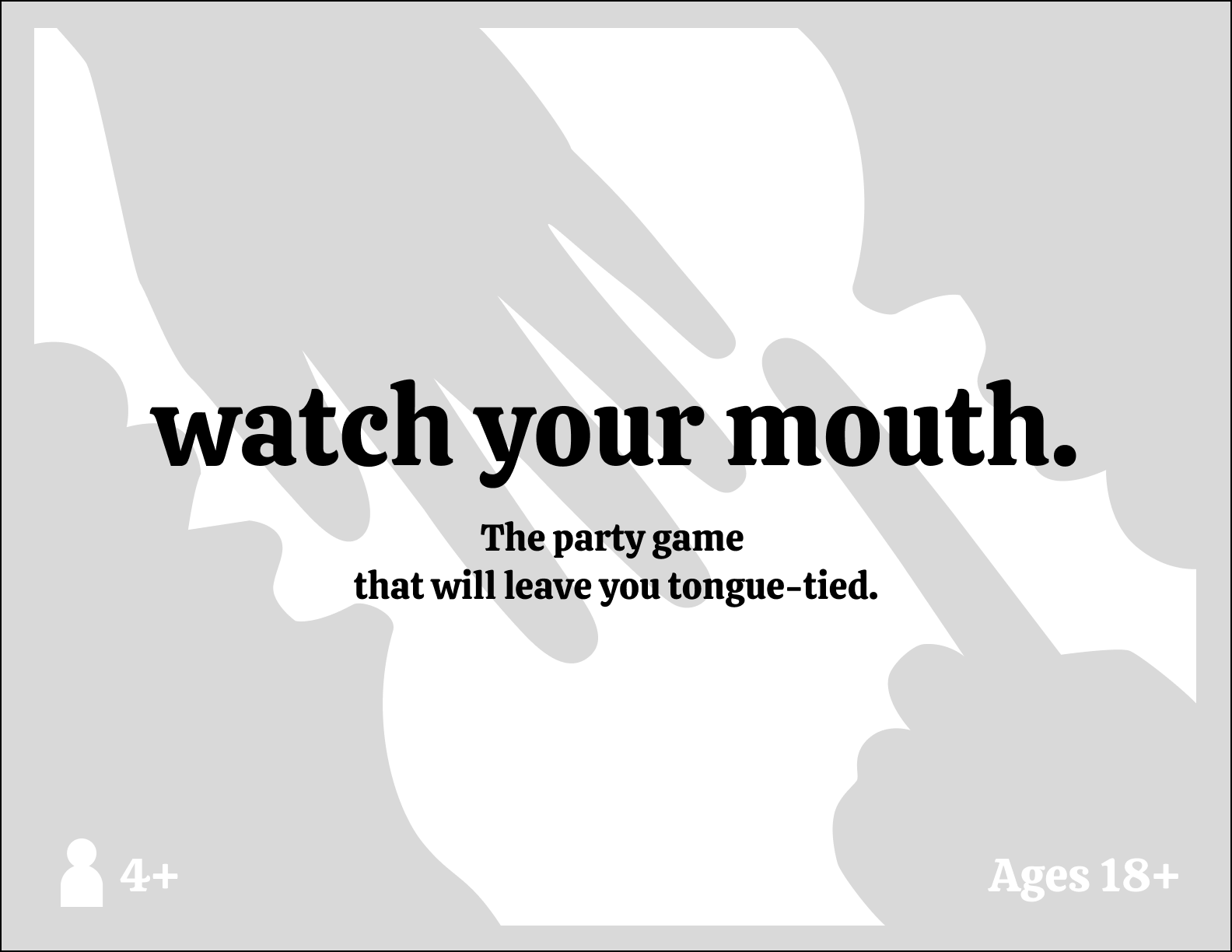Watch Your Mouth
CS 247G – Social Game Project

Group Members
Uma Phatak
Frankie Sperka
Daphne Wilkerson
Artist’s Statement
Watch Your Mouth is a party game for players 18 years or older, and for groups of four or more. Our game has players collaboratively creating new and silly stories a few words at a time, but the rules and the stories are never the same. A variety of new rule cards change what you’re allowed to say, and each team is given secret word cards that they have to sneak into the story without being noticed. On top of that, character, setting, and action cards can be used to give your story a place to start before it gets wildly out of hand.
We, the game creators, can’t help but love games that descend into chaos. Players must keep track of rule-stacking, secret words, and narrative structure all at once, and it only gets harder as the game keeps going. We think this mayhem is the perfect way to spice up a party or to get total strangers laughing together. Experienced players will discover strategies for earning more points and tripping up the other team, but our game needs no more than five minutes of learning before a player can hit the ground running. Watch Your Mouth is never the same game twice, but it’s always a tongue-tying triumph!
Mindmap of Game System
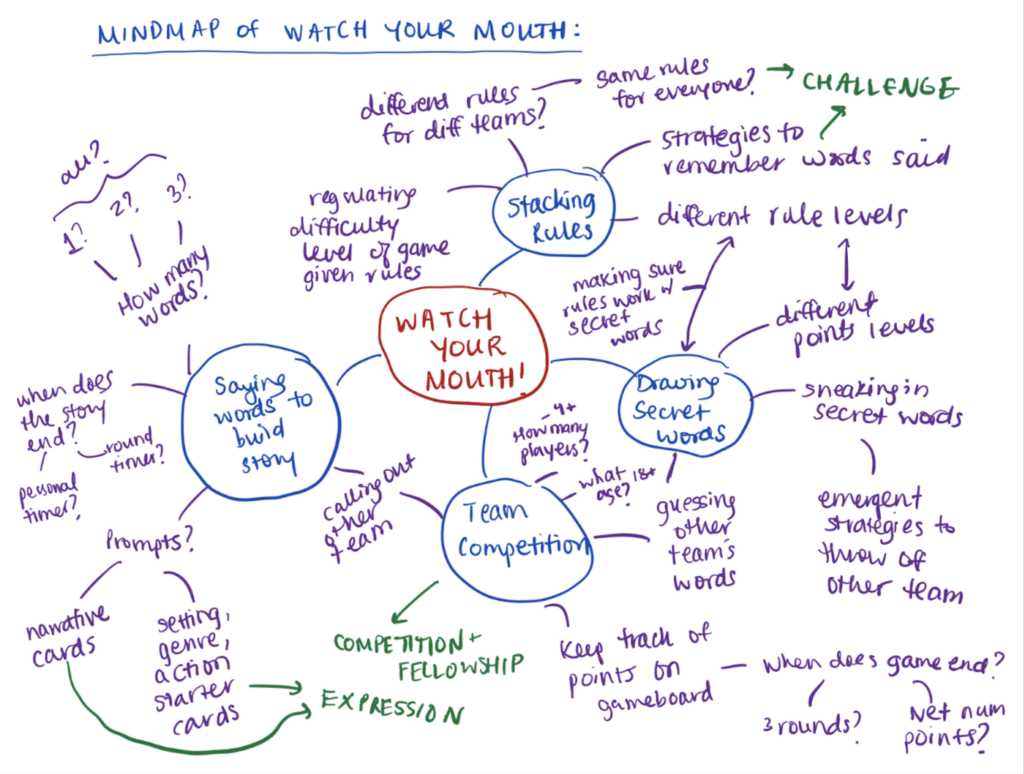
Mindmap.
- The name of the game is in the middle, in red.
- The core mechanics branch off in blue.
- The resulting dynamics and design questions branch off in purple
- The final aesthetics are annotated in green next to the mechanics and dynamics that help create them
Initial Game Version
Our initial version of Watch Your Mouth established the core gameplay formal elements; namely, that players would split in two teams, and that new rule cards would limit what could and couldn’t be said. We knew from the start that we wanted two teams, as we thought bilateral competition was the best type of competition out of the types we learned in class for a social game. However, we wanted rules to apply to each team separately, such that each team would follow different rules. Additionally, instead of cards for character, setting, and action, we had a single deck of prompt cards in fill-in-the-blank style, such as:
I never really learned to ______ my ______.
Each blank would be filled in by one team, respectively, and the whole group would try to shape the narrative according to the filled-in prompt. To add more time pressure, the team of the person who was thinking of a new word when the two-minute timer finished, would lose a point.
We wanted to achieve the following aesthetics of fun, in the following order: Competition, Challenge, Fellowship, Expression. The iteration log below explains how we iterated on this initial version of the game to produce a final version that best provides these types of fun.

Initial Game Version: Initial game ideation, which was focused on core mechanics (right).
Gameplay Iteration Log
The iterations are described using an MDA framework: we explicitly detail the mechanics and formal elements that worked well and didn’t work well. We justify whether they worked well or not by explaining the dynamics that arose due to the mechanic, and if relevant, the aesthetic that this detracted from or contributed to.
We realized quickly that for the type of humor we wanted in our cards, we wanted our target audience to be 18+. We playtested with this audience accordingly.
Playtest 1: In-class, with a group of four.
Guiding question: Is our idea of a narrative game with stacking rules and teams even fun?
Mechanics that worked well:
- Stacking rules made the progression of the game interesting and kept players’ attention. It added well to the aesthetic of Challenge.
- The premise of the game was fun and made sense to all, which was promising.
Mechanics that didn’t work (and how we changed them):
- There were too many rules to keep track of when each team had their own rules
- We made all rules apply to the whole group. Thus, we also scrapped fill-in-the-blanks on rule cards, so the whole group wouldn’t just choose easy rules for themselves.
- Prompt cards were interesting, but it was difficult to keep the story on track with the prompt.
- We scrapped prompt cards in favor of secret word cards and points, to maintain a narrative prompt with actual incentives tied in. This also responded to TA feedback from Checkpoint 1 that wanted more complexity, specifically: “encourage additional collaborative storytelling”, and “add unexpected events and curves to your collaborative story”.
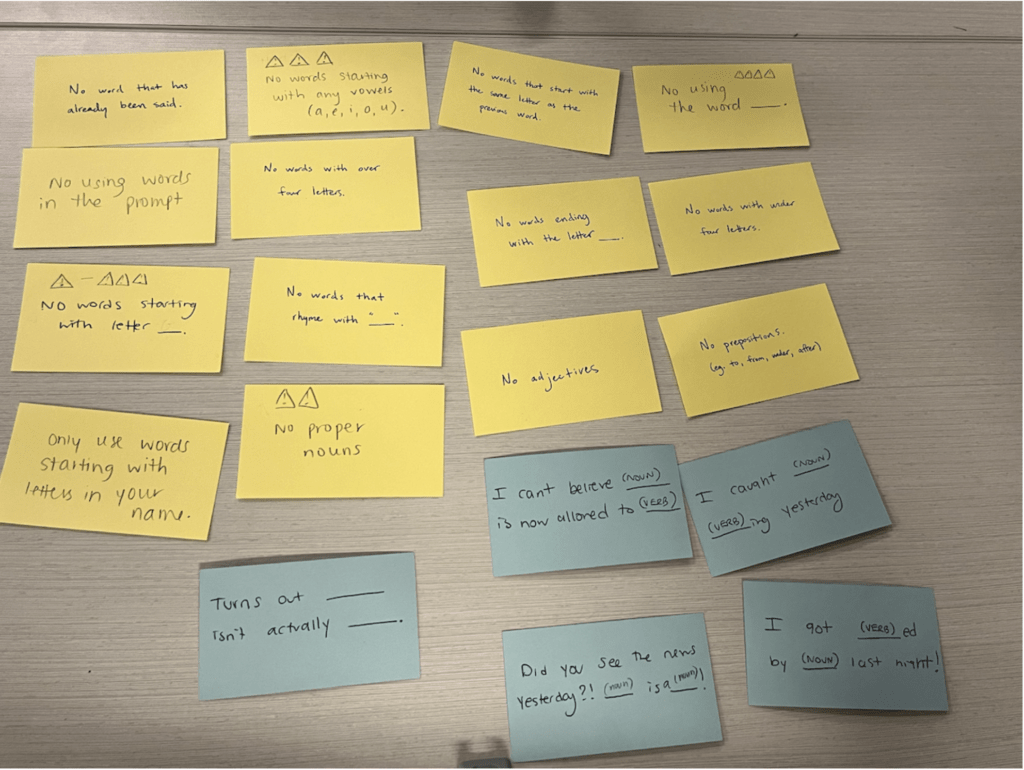
Used in Playtest 1: Our initial cards. Note the prompt cards, which we scrapped in Playtest 2.
Playtest 2: In-class, with a group of four (including two players from our team)
Guiding question: How do the secret cards work both as a replacement for prompt cards, and as a standalone mechanic?
Mechanics that worked well:
- Secret word cards proved to be a more exciting mechanic than prompt cards, and added to the aesthetic of Fellowship: now, teams had a shared secret goal.
- Players could successfully sneak in secret words without the other team noticing, and enjoyed this level of Challenge more.
Mechanics that didn’t work (and how we changed them):
- Some confusion over incompatibility between rule cards and secret word cards (e.g. what if my secret word starts with a “T”, which I can’t say?)
- We needed to rewrite rule cards to be more lenient, to accommodate the new secret words cards
- It was difficult for players to keep track of their team’s score throughout the game.
- We introduced a game board to help players keep track of the score visually. Thus responded to TA feedback from Checkpoint 3.
- Players didn’t realize how close the timer was to running out, so the mechanic where a team would lose a point at the end of the round felt randomly imposed.
- We kept the timer to add to Challenge, but we scrapped the point-loss mechanic.
Playtest 3: In-class, with a group of four
Guiding question: Does our game achieve the types of fun we are aiming for (Competition, Challenge, Fellowship, Expression)?
Mechanics that worked well:
- Our point-tracking ‘tug-of-war’ system was successful and novel for keeping track of score and showing when a team won the game. This contributed to Competition.
- We introduced the option of saying one or two words at once, which allowed for more strategic play, adding to Fellowship.
Mechanics that didn’t work (and how we changed them):
- Players didn’t like that rounds ended so quickly, especially in rounds with more rules.
- We increased the round length to 3 minutes.
- Some secret word cards were harder to incorporate than others.
- We introduced a variable point value system for secret words.
- Rules that required knowledge of parts of speech (such as proper nouns, adjectives, etc.) created some confusion.
- We decided to scrap this type of rule altogether to reduce confusion.
- Players felt like the narratives they created in each round were too random and needed more direction.
- We created setting, character, and genre card decks to give each round a different starting point for the narrative, and to encourage Expression.
- Some rule cards still conflicted with one another when stacked, and had to be discarded/redrawn.
- To maintain the rule stacking mechanic (our favorite), we instead decided to add levels for the rule cards. Different levels apply to different rounds as the game progresses, so it gets harder over time. In this way, we could put conflicting rules in the same level, so they would never stack together. This also helped track rule stacking, and the progression of the game (TA feedback from Checkpoint 3).
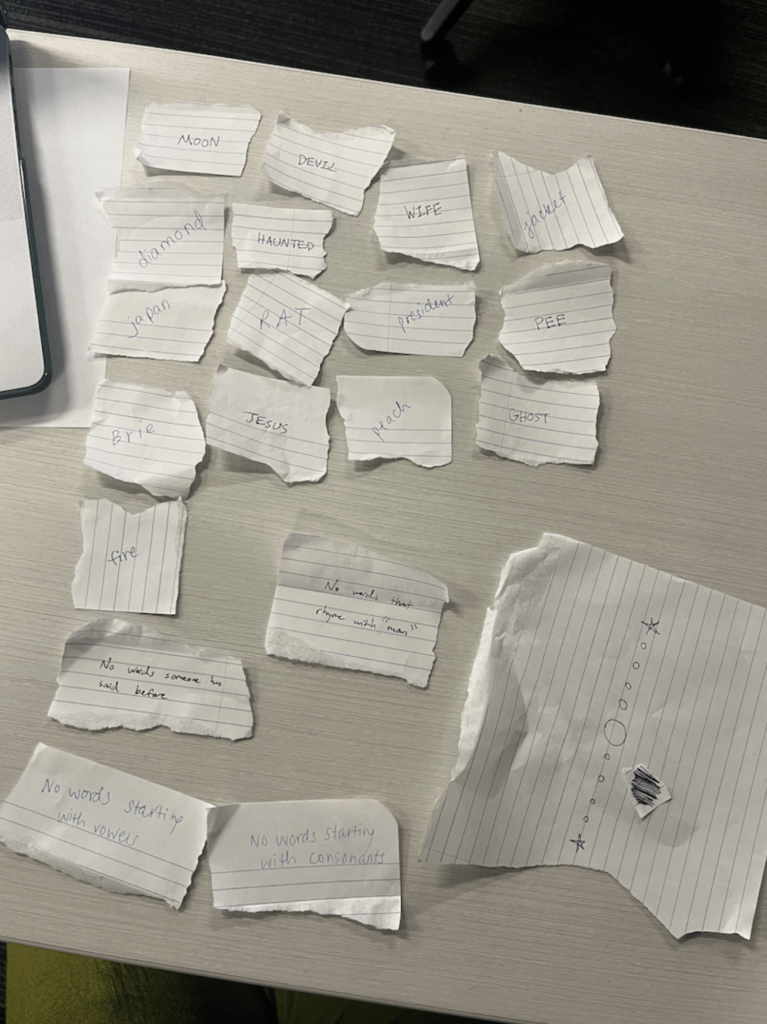
Used in Playtest 3: Our new cards, which combined the secret word cards and gameboard with the old rules.
Playtest 4: Out of class, with a group of four
Guiding question: Does adding levels to the rules make all elements of the game work together more seamlessly? How does the game function as a whole, as this is our last playtest?
Mechanics that worked well:
- The rule levels were a great way to prime the players to the growing difficulty of the game as rules stacked, and encouraged more buy-in from them.
Mechanics that didn’t work (and how we changed them):
- The genre cards were never followed. Additionally, the character + setting + genre combination was sometimes hard to get around to working into the story.
- We made genre cards, action cards, instead. Then, we made the game start with a sentence “Once upon a time, character was at setting, action.” so that players can easily add onto this already primed narrative. This aligned with TA feedback from Checkpoint 3. We also expanded our range of cards quite a bit to make them more humorous (also aligned with feedback from Checkpoint 3.)
- One or two words per person was not enough for gameplay to flow.
- We allowed people to say 1 – 3 words instead of just one or two, in keeping with TA feedback from Checkpoint 1.
- Rule balance wise, Level 3 rules were almost prohibitively hard, and the range of Level 1 rules was too large (e.g. rhyming rules are not the same difficulty as letter starting rules.) We investigated this in response to TA feedback from Checkpoint 3.
- We made level 1 rules only rhyming, Level 2 rules primarily letter starting, and added behavioral rules to Level 3 rules since we found that they made both harder and more fun, without completely stopping the flow of gameplay. In this way, we think we have addressed the feedback.
- There was some confusion on more minute rules. This
- We tidied up some rules (Who starts? Who starts guessing secret words? Does the starting team switch each time?)
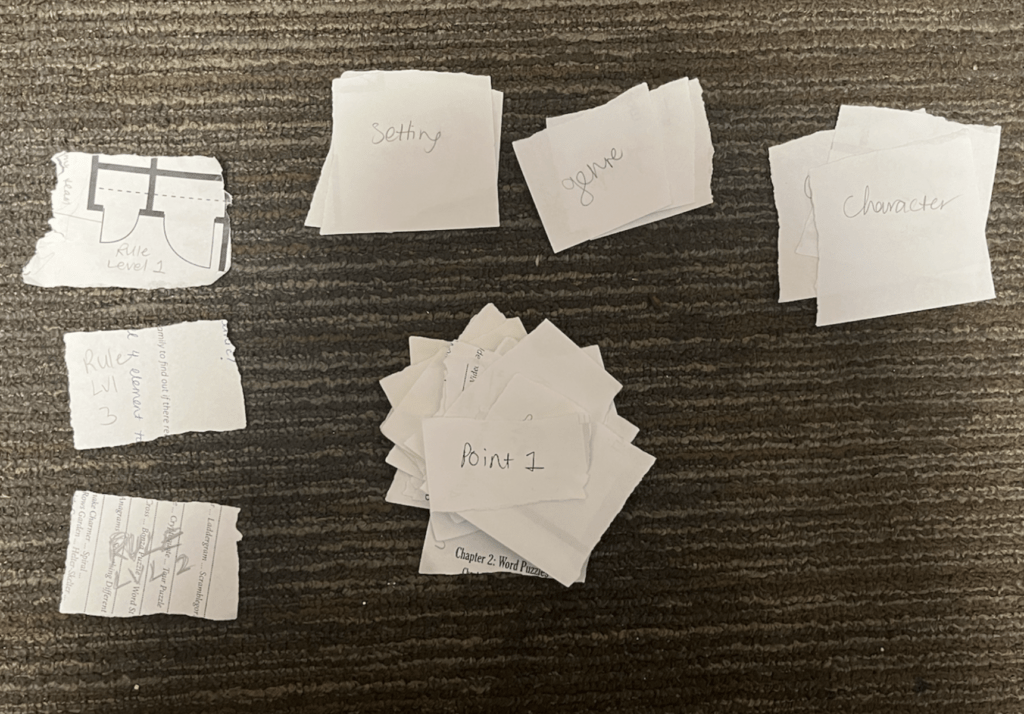
Used in Playest 4: Our final playtest cards, before printing. Note the Rule Levels, points on the Secret Word cards, and replacement of prompts with character, setting, genre.
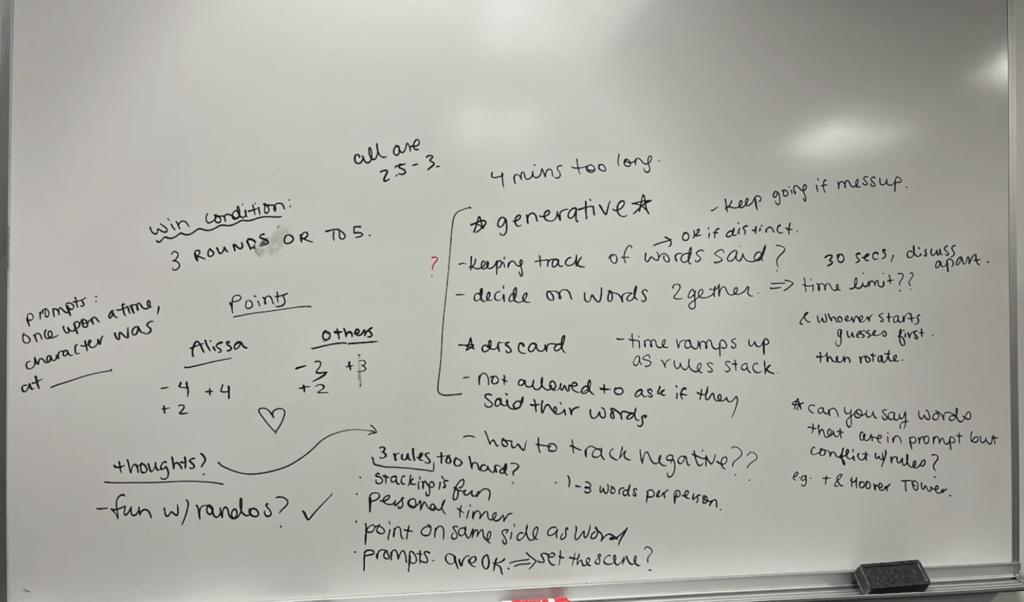
After Playtest 4: Notes from one of our final playtests.
After expanding our card deck, by the end, we had dozens of cards that had been read over by playtesters. We think our deck of cards provides a clear vibe and theme that is similar to Cards Against Humanity (cheeky, irreverent, humorous, not too serious). We have also playtested our game ourselves multiple times and think it’s a great party game!
We loved seeing all the emergent dynamics that arose: saying multiple weird words together to throw the other team off as to which is the secret one, setting up a teammate to say a secret word, setting up an opponent to say a word that violates a rule, and more! See the playtest video for more.
Visual Design Iteration Log
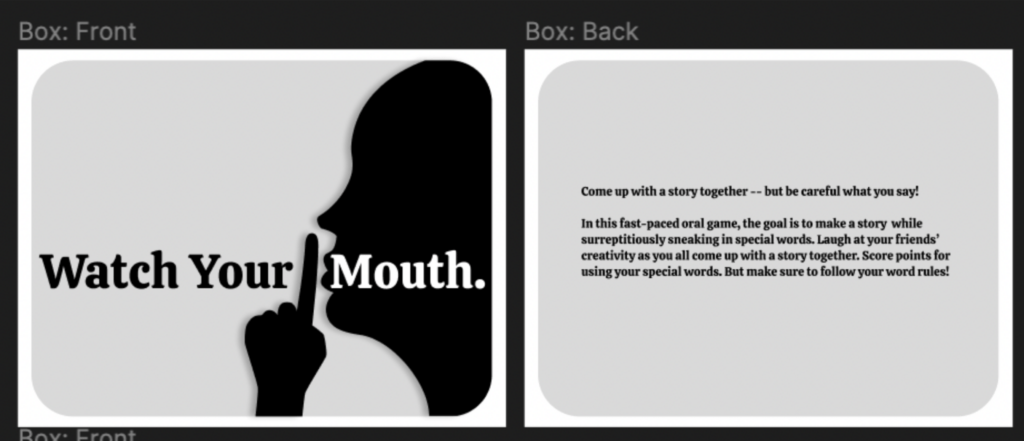
First iteration
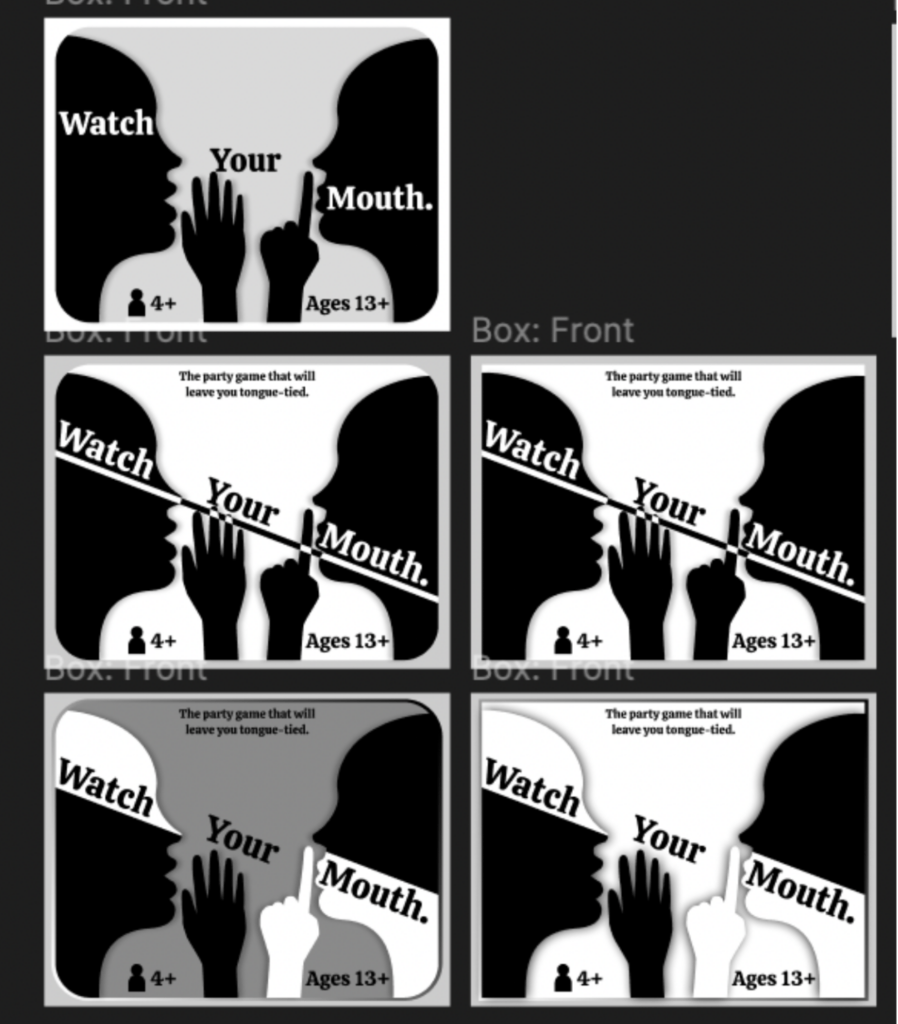
Iterations with heads motif
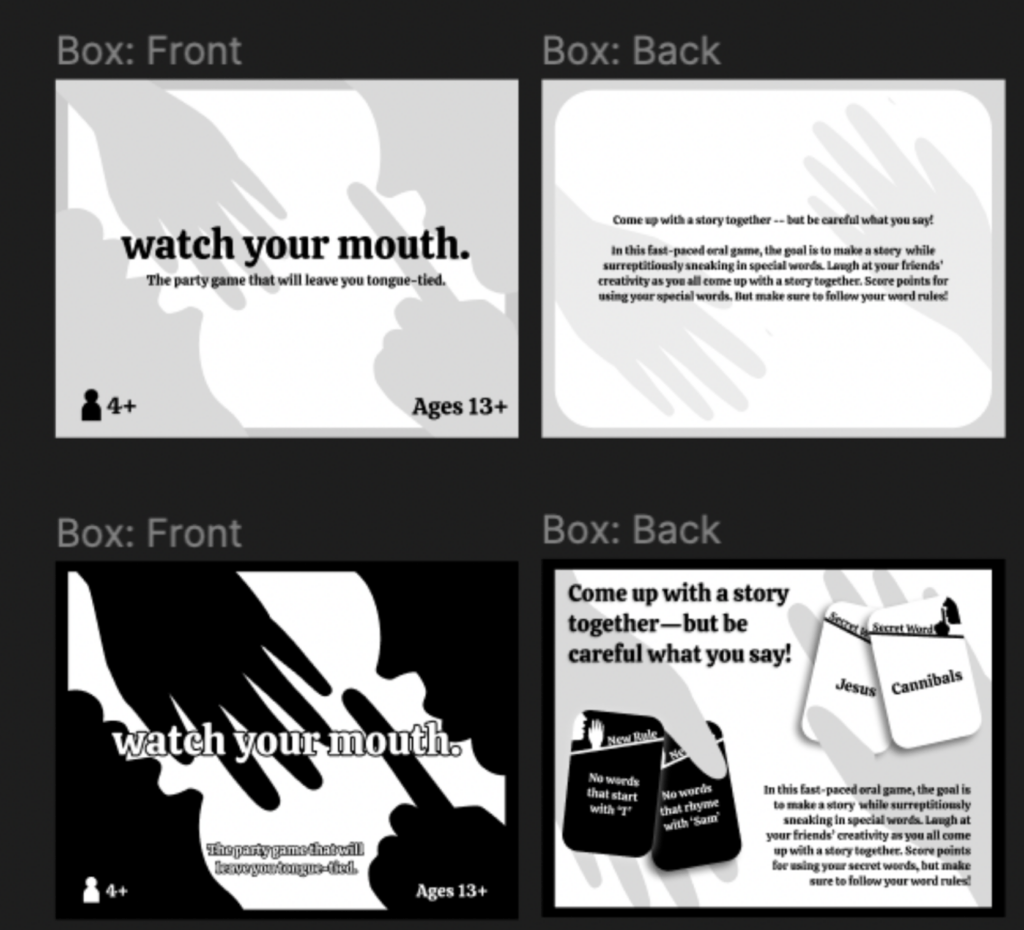
Iterations with hands and heads motif
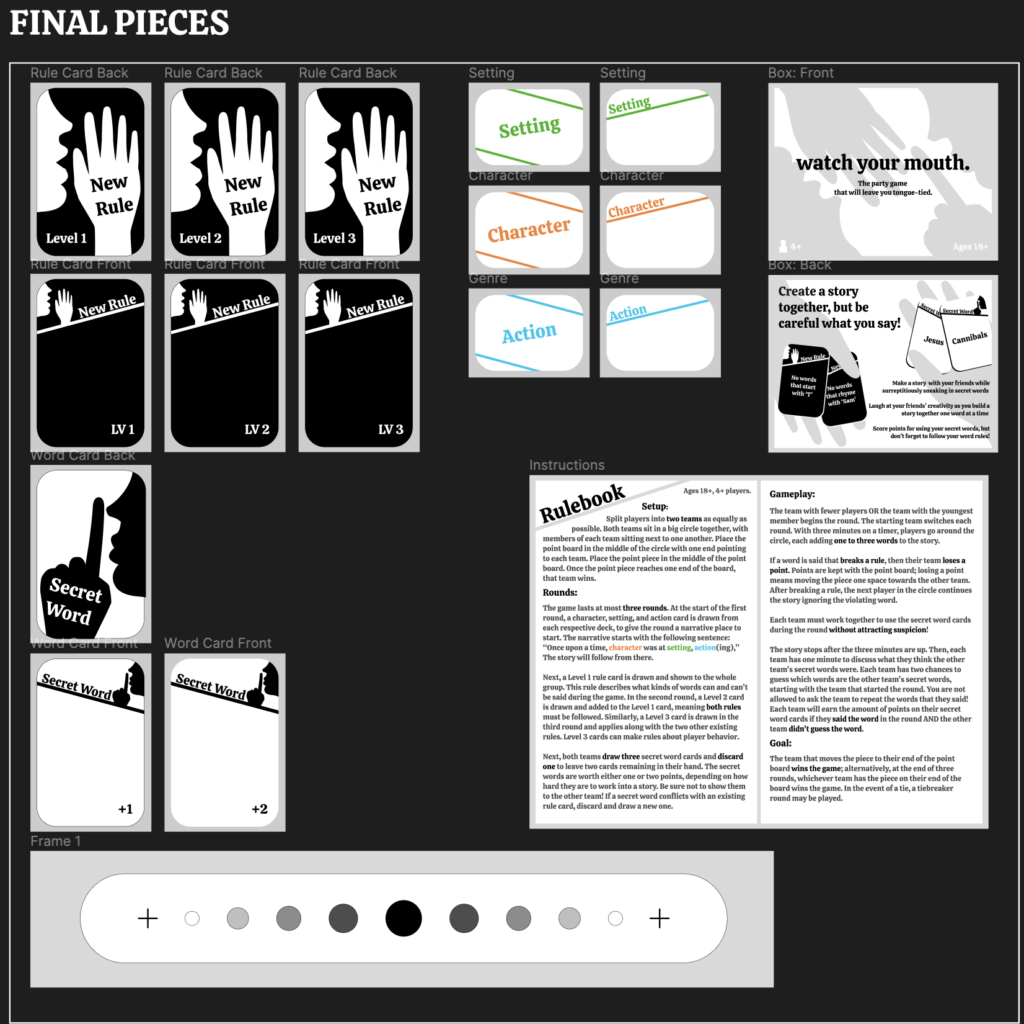
Final design
We didn’t playtest with our actual cards, but we showed our playtesters our final design cards during Playtest 4 and they liked the minimalist design, and the “cheeky” design of the box and cards (quote from a playtester!) For this reason, we did not incorporate TA feedback from Checkpoint 3 about making the box more about the storytelling, opting to focus on the images of the humans in the act of storytelling (saying ‘sh’, saying a word).
Final Prototype

Setup of final game – bird’s eye view.
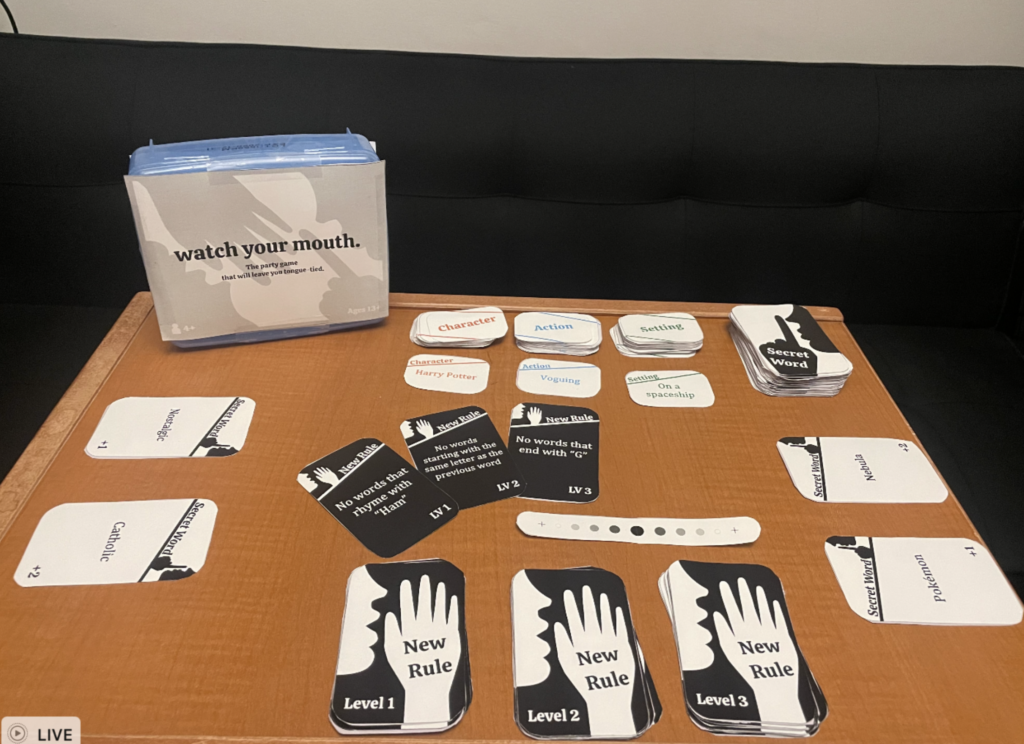
Setup of final game – lateral view.
Each team (left and right sides of the table) has two secret word cards (usually hidden) to work into the story. The prompts are at the top of the table. The story will start: “Once upon a time, Harry Potter was on a spaceship, voguing.” Gameplay starts from there. In this setup, players are on the third round, meaning all three rules in the center of the table stack on each other. The gameboard and box are also shown.
Video of Final Playtest
Link to playtest: https://youtu.be/qaRej7D85o0
Relevant Timestamps:
0:00 – 4:04: First round (lots of learning the rules of the game)
1:43-2:10 : Emergent strategy for sneaking in secret words! (Say three similar weird
words together)
3:06 – 4:04: Secret word discussion and guessing
8:13 – 13:40: Second round
8:20 – 9:25: Rule stacking in action: player pivots when they realize
12:10 – 13:40: Secret word discussion and guessing
18:35 – 27:15: Third round (hardest, more rule violations, but also most emergent strategy and lots of laughing!)
19:00 – 19:20: Emergent strategy used by other team!
24:27 -27:15 : Secret word discussion, where teams cannot remember what strange
words were said by the opposing team, which makes the process much longer
27:30 – End: Left team wins, everyone says the game is fun!
This was our final playtest, which we did after the final class playtest. It was meant to ensure that the balance of the game was appropriate right before we made our final print and play, to respond to TA feedback after Checkpoint 3.
Changes we made from this playtest are listed above. Mainly, we found that the rules were not at a consistent level within each round, and got to be too hard by the end. The secret words of point value 1 were also a bit too hard. So, we changed these aspects for our final print and play (more standard rules per round, more behavioral rules for Level 3 since these were fun, and easier secret words).
Changes we would make with more time:
- Maybe incorporate a whiteboard so people can remember what was said. However, when polled, players said they also enjoyed the aspect of not remembering exactly what was said. So, this would take more playtesting.
- We would play around with having a personal timer instead of a round timer (feedback from final playtest).
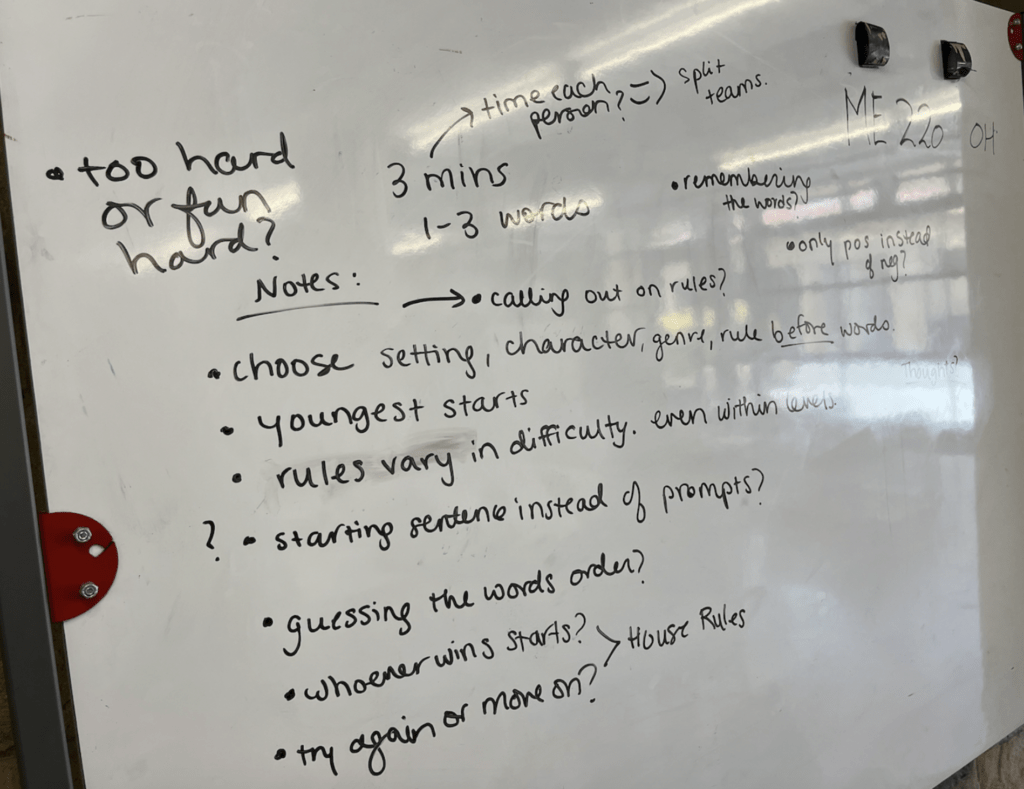
After Playtest 4: Notes from our final playtest.
Link to Print-n-Play
Our Print-n-Play can be found here.
The only pieces not provided in the print-n-play are a piece to keep track of the score on the gameboard (provided on Page 1), and a timer. For the score piece, any small item the user owns – an eraser, a pen placed vertically, a coin – would work to keep track of the score. For the timer, a phone can be used.
The flair and humor of the game is most visible in the character/setting/action cards (Page 67 – 98)
Design Mockups

Box: Front

Box: Back
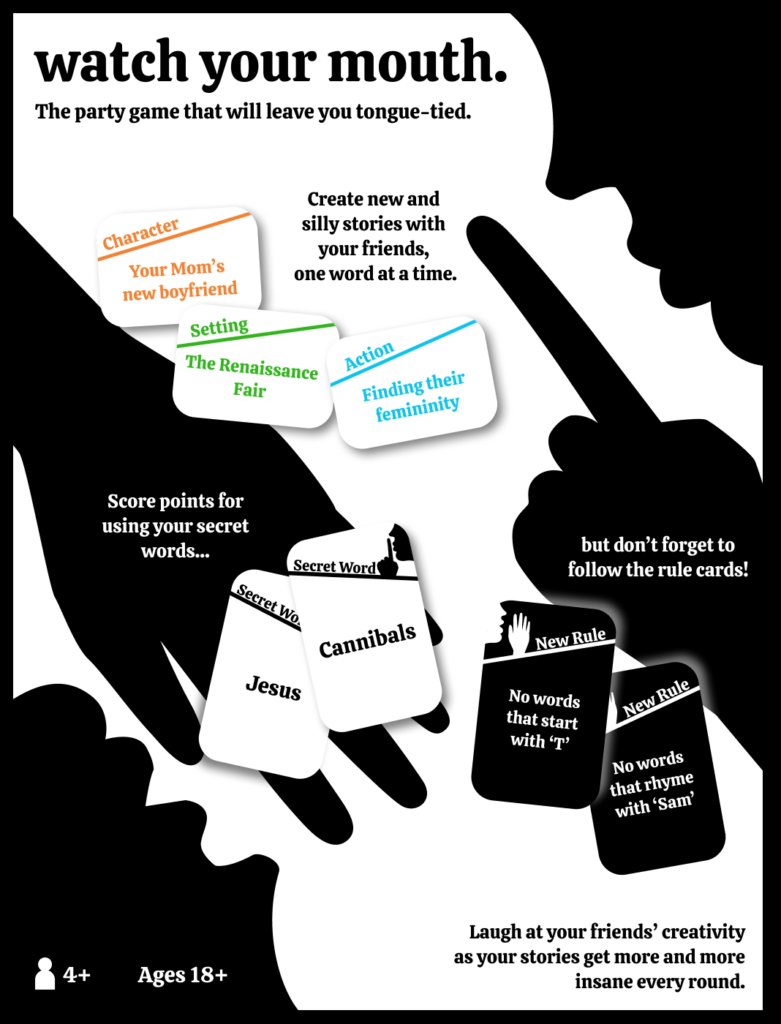
Game advertisement
Rulebook
Target Audience: 18+, 4+ players.
Setup:
Split players into two teams as equally as possible. Both teams sit in a big circle together, with members of each team sitting next to one another. Place the point board in the middle of the circle with one end pointing to each team. Place the point piece in the middle of the point board. Once the point piece reaches one end of the board, that team wins.
Rounds:
The game lasts at most three rounds. At the start of the first round, a character, setting, and action card is drawn from each respective deck, to give the round a narrative place to start. The narrative starts with the following sentence: “Once upon a time, character was at setting, action(ing),” The story will follow from there.
Next, a Level 1 rule card is drawn and shown to the whole group. This rule describes what kinds of words can and can’t be said during the game. In the second round, a Level 2 card is drawn and added to the Level 1 card, meaning both rules must be followed. Similarly, a Level 3 card is drawn in the third round and applies along with the two other existing rules. Level 3 rules can also be behavioral.
Last, both teams draw three secret word cards and discard one to leave two cards remaining in their hand. The secret words are worth either one or two points, depending on how hard they are to work into a story. Be sure not to show them to the other team! If a secret word conflicts with an existing rule card, discard and draw a new one.
Gameplay:
The team with fewer players OR the team with the youngest member begins the round. The starting team switches each round. With three minutes on a timer, players go around the circle, each adding one to three words to the story.
If a word is said that breaks a rule, then their team loses a point. Points are kept with the point board; losing a point means moving the piece one space towards the other team. After breaking a rule, the next player in the circle continues the story ignoring the violating word.
Each team must work together to use the secret word cards during the round without attracting suspicion!
The story stops after the three minutes are up. Then, each team has one minute to discuss what they think the other team’s secret words were. After two minutes, each team has two chances to guess which words are the other team’s secret words, starting with the team that started the round. You are not allowed to ask the team to repeat the words that they said! Each team will earn the amount of points on their secret word cards if they said the word in the round AND the other team didn’t guess the word.
Goal:
The team that moves the piece to their end of the point board wins the game; alternatively, at the end of three rounds, whichever team has the piece on their end of the board wins the game. In the event of a tie, a tiebreaker round may be played.


